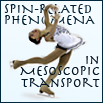Speaker
Alberto Bramati
Description
Exciton-polaritons are mixed light-matter quasi-particles
arising from the strong coupling between photons and
excitons in a micrometer sized cavity with embedded quantum
wells. They have been studied extensively since the
discovery of strong light–matter coupling in these systems
in 1992. Polaritons are bi-dimensional composite bosons that
can exhibit macroscopic quantum coherence effects at high
temperatures (5-300K) due to their very low mass (~10-4
times that of the electron, inherited from their photonic
component). In particular, polaritons behave as a quantum
fluid with specific properties coming from their out of
equilibrium nature, determined by their short lifetime (few
picoseconds) [1-3]. At the same time, microcavity
polaritons, due to the strong spin dependent non-linear
polariton-polariton interactions (inherited from their
excitonic component), are very promising for the realization
of integrated optoelectronic devices opening the way both to
operation at the quantum level and to spin based architectures.
In this talk I will first discuss our recent observation of oblique dark half-solitons in a spinor polariton quantum fluid diretly created by resonant laser excitation in an InGaAs semiconductor microcavity. In the second part of the talk I will discuss the perspectives opened by semiconductor microcavities as tools for all-optical information processing, due to their low-threshold, polarization-dependent nonlinear emission, fast operation and integrability. In particular I will show how the spin-dependent polariton-polariton interactions can be exploited to implement a polarization controlled optical gate [4] as well as a non-local, all-optical spin switch [5], potentially working at high rates due to the large polariton velocity and reduced lifetime.
[1] A. Amo, J. Lefrère, S. Pigeon, C. Adrados, C. Ciuti, I. Carusotto, R. Houdré, E. Giacobino, A. Bramati, Nature Physics 5, 805 (2009).
[2] A. Amo, S. Pigeon, D. Sanvitto, V. G. Sala, R. Hivet, I. Carusotto, F. Pisanello, G. Leménager, R. Houdré, E. Giacobino, C. Ciuti and A. Bramati, Science, 332,1167 (2011).
[3] D. Sanvitto, S. Pigeon, A. Amo, D. Ballarini, M. De Giorgi, I. Carusotto, R. Hivet, F. Pisanello, V. G. Sala, P. S. S. Guimaraes, R. Houdré, E. Giacobino, C. Ciuti, A. Bramati & G. Gigli, Nature Photonics, 5, 610 (2011).
[4] C. Leyder, T. C. H. Liew, A. V. Kavokin, I. A. Shelykh, M. Romanelli, J.-Ph. Karr, E. Giacobino and A. Bramati, Phys. Rev. Lett. 99, 196402 (2007).
[5] A. Amo, T.H.C Liew, C. Adrados, A.V. Kavokin, R. Houdré, E. Giacobino and A. Bramati, Nature Photonics, 4, 361 (2010).
In this talk I will first discuss our recent observation of oblique dark half-solitons in a spinor polariton quantum fluid diretly created by resonant laser excitation in an InGaAs semiconductor microcavity. In the second part of the talk I will discuss the perspectives opened by semiconductor microcavities as tools for all-optical information processing, due to their low-threshold, polarization-dependent nonlinear emission, fast operation and integrability. In particular I will show how the spin-dependent polariton-polariton interactions can be exploited to implement a polarization controlled optical gate [4] as well as a non-local, all-optical spin switch [5], potentially working at high rates due to the large polariton velocity and reduced lifetime.
[1] A. Amo, J. Lefrère, S. Pigeon, C. Adrados, C. Ciuti, I. Carusotto, R. Houdré, E. Giacobino, A. Bramati, Nature Physics 5, 805 (2009).
[2] A. Amo, S. Pigeon, D. Sanvitto, V. G. Sala, R. Hivet, I. Carusotto, F. Pisanello, G. Leménager, R. Houdré, E. Giacobino, C. Ciuti and A. Bramati, Science, 332,1167 (2011).
[3] D. Sanvitto, S. Pigeon, A. Amo, D. Ballarini, M. De Giorgi, I. Carusotto, R. Hivet, F. Pisanello, V. G. Sala, P. S. S. Guimaraes, R. Houdré, E. Giacobino, C. Ciuti, A. Bramati & G. Gigli, Nature Photonics, 5, 610 (2011).
[4] C. Leyder, T. C. H. Liew, A. V. Kavokin, I. A. Shelykh, M. Romanelli, J.-Ph. Karr, E. Giacobino and A. Bramati, Phys. Rev. Lett. 99, 196402 (2007).
[5] A. Amo, T.H.C Liew, C. Adrados, A.V. Kavokin, R. Houdré, E. Giacobino and A. Bramati, Nature Photonics, 4, 361 (2010).

